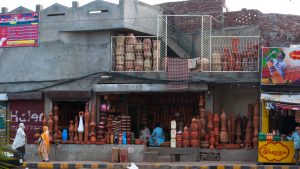Sania Zeb

Pakistan is facing existential economic challenges, political instability, and a natural calamity of historical proportions that has exacerbated structural fault lines.
Although its problems are primarily made in Pakistan, regional and international economic realities have aggravated the economic situation. Surging inflation and deteriorating macroeconomic fundamentals in Pakistan are a byproduct of globalization and a highly interlinked supply chain mechanism, besides domestic supply and structural issues. It impacts lower-income groups with a higher intensity, which escalates fragmentation in society.
The World Bank reports that the ongoing Ukraine conflict has dramatically altered the already volatile post-COVID financial, energy, and fertilizer markets. It has led to skyrocketing food inflation and increased the cost of living by 200-300 percent. The global economic outlook remains grim, even though consumer price index (CPI) inflation rates have started to decline slowly in recent months. Central banks continue to raise interest rates amid fears of persistent underlying inflationary pressures.
The most pressing concern is a persistent increase in food inflation, which can lead to a decline in purchasing power, a reduction in consumer spending and ultimately impact economic growth.
Food is a basic necessity. Currently, food inflation is at its highest in 45 years in Pakistan. At present, CPI food inflation in Pakistan stands at 42.1 percent, which is expected to increase further as the weekly Sensitive Price Indicator (SPI) revealed 41.54 percent inflation, quoting a major increase in food item prices. This will only increase inequality as monetary policy in itself is considered ineffective. Rising food prices can disproportionately affect low-income households, pushing them further into poverty.
The global spillover effect is of critical importance for explaining the sharp increase in inflation in Pakistan. This is a two-way process. Inflation in Pakistan not only affects Pakistan, but it also affects other countries through a decline in bilateral trade, investment, and migration besides creating regional inequalities and regional instability.
Moreover, it leads to an inflationary spiral, which can trigger a chain reaction, leading to increased costs of production, higher wages, and further inflation in the overall economy, which catalyzes political instability. Food is a sensitive issue, especially in the developing world. Rising food prices can lead to social unrest and political instability, particularly in countries with high levels of poverty and food insecurity, which in turn can also lead to trade tensions, as countries seek to protect their domestic food supplies and limit exports. Recently, video clips of less fortunate people standing in long queues and running after trucks carrying wheat vent viral. This kind of content only serves to add fuel to fire.
Pakistan remains a highly unequal society, and the divide between the haves and have-nots is only increasing, which is further aggravated by global currency and commodity market spillovers besides the historical floods of 2022. Increasing fragmentation suggests that the poverty rate may increase by 2.5-4 percent, pushing between 5.8 and 9 million people into poverty.
Therefore, addressing this issue is important for both economic stability and social well-being.
The government can take several measures to address food inflation, such as adopting policies to increase agricultural productivity, improving supply chain mechanisms, and implementing price stabilization policies.
Since January 2023, Pakistan’s CPI has been at 27.6 percent, although it is expected to rise to around 33 percent, increasing the inflationary gap between urban and rural areas. It can contribute to regional fragmentation by worsening existing economic disparities and reducing economic mobility.
Compared to rural areas, urban Pakistan generally has higher levels of economic development, access to better infrastructure, and greater exposure to global markets. As a result, urban areas are often less affected by inflation and have more resilience to cope with its impacts. On the other hand, rural areas are often more vulnerable to inflation, as they have limited access to essential goods and services and face greater challenges in securing food and other basic necessities.
Therefore, the government and other stakeholders need to address the rising inflationary gap between urban and rural areas in Pakistan and ensure that economic development and opportunities are distributed more evenly across the country. This may involve investing in rural infrastructure, promoting rural-urban economic linkages, and implementing policies that support small farmers and rural businesses. This can kick-start the economic rejuvenation process.
Even though global inflationary pressures are estimated to ease down in the first quarter of 2023, reaching 6.5 percent and then falling to 4.5 percent in 2024, delayed pass-through of higher commodity prices and exchange rate fluctuations will continue to increase inflationary pressures in emerging and developing countries. Potential energy price hikes, ongoing de-globalization, structural labor market problems, and faster-than-anticipated economic recovery in China remain among the key risks and could accelerate price growth in 2023.
However, the trend in global food inflation can be volatile and subject to sudden changes, depending on factors such as weather patterns, crop yields, and geopolitical events. So, it’s difficult to predict the exact trend of food inflation at any given time. Nevertheless, ensuring food security and stability in the global food system remains an important challenge and a priority for governments and international organizations.
No comments:
Post a Comment